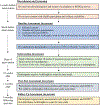Improving multimodal physical function in adults with heterogeneous chronic pain; Protocol for a multisite feasibility RCT
- PMID: 38286223
- PMCID: PMC10932927
- DOI: 10.1016/j.cct.2024.107462
Improving multimodal physical function in adults with heterogeneous chronic pain; Protocol for a multisite feasibility RCT
Abstract
Background: Chronic pain is associated with substantial impairment in physical function, which has been identified as a top concern among persons with pain. GetActive-Fitbit, a mind-body activity program, is feasible, acceptable, and associated with improvement in physical function among primarily White, sedentary individuals with pain. In preparation for a multisite efficacy trial, we must examine feasibility across multiple sites with diverse patient populations. Here we describe the protocol of a multisite, feasibility RCT comparing GetActive-Fitbit with a time- and attention-matched educational comparison (Healthy Living for Pain). We aim to 1) test multisite fidelity of clinician training; 2) evaluate multisite feasibility benchmarks, including recruitment of chronic pain patients taking <5000 steps/day and racial and ethnic minorities; and 3) optimize fidelity and study protocol in preparation for a future multisite efficacy trial.
Methods: Clinician training fidelity was assessed via roleplays and mock group sessions. Feasibility (i.e., recruitment, acceptability, credibility, adherence, satisfaction), multimodal physical function (e.g., self-report, 6-Minute Walk Test, step-count), and other psychosocial outcomes are assessed at baseline, posttest, and 6 months. Protocol optimization will be assessed using exit interviews and cross-site meetings.
Results: The trial is ongoing. Clinician training is complete. 87 participants have been recruited. 54 completed baseline assessments and randomization, 44 are mid-intervention, and 9 have completed the intervention and posttest.
Conclusions: This study addresses the critical need for feasible, acceptable mind-body-activity interventions for chronic pain that follow evidence-based guidelines and improve all aspects of physical function across diverse populations. Results will inform a future fully-powered multisite efficacy trial.
Clinical trial registration: NCT05700383.
Keywords: Chronic pain; Feasibility; Mind-body; Physical function; Step count.
Copyright © 2024 Elsevier Inc. All rights reserved.
Conflict of interest statement
Declaration of competing interest The authors declare that they have no known competing financial interests or personal relationships that could have appeared to influence the work reported in this paper.
Figures
Similar articles
-
A Mind-Body Physical Activity Program for Chronic Pain With or Without a Digital Monitoring Device: Proof-of-Concept Feasibility Randomized Controlled Trial.JMIR Form Res. 2020 Jun 8;4(6):e18703. doi: 10.2196/18703. JMIR Form Res. 2020. PMID: 32348281 Free PMC article.
-
A Live Video Program to Prevent Chronic Pain and Disability in At-Risk Adults With Acute Orthopedic Injuries (Toolkit for Optimal Recovery): Protocol for a Multisite Feasibility Study.JMIR Res Protoc. 2021 Apr 28;10(4):e28155. doi: 10.2196/28155. JMIR Res Protoc. 2021. PMID: 33908886 Free PMC article.
-
Live Video Adaptations to a Mind-Body Activity Program for Chronic Pain and Cognitive Decline: Protocol for the Virtual Active Brains Study.JMIR Res Protoc. 2021 Jan 4;10(1):e25351. doi: 10.2196/25351. JMIR Res Protoc. 2021. PMID: 33208301 Free PMC article.
-
Improving Health for Older Adults With Pain Through Engagement: Protocol for Tailoring and Open Pilot Testing of a Mind-Body Activity Program Delivered Within Shared Medical Visits in an Underserved Community Clinic.JMIR Res Protoc. 2023 Dec 29;12:e52117. doi: 10.2196/52117. JMIR Res Protoc. 2023. PMID: 38157234 Free PMC article.
-
Development and evaluation of a de-escalation training intervention in adult acute and forensic units: the EDITION systematic review and feasibility trial.Health Technol Assess. 2024 Jan;28(3):1-120. doi: 10.3310/FGGW6874. Health Technol Assess. 2024. PMID: 38343036 Free PMC article.
Cited by
-
A Mindfulness-Based Lifestyle Intervention for Dementia Risk Reduction: Protocol for the My Healthy Brain Feasibility Randomized Controlled Trial.JMIR Res Protoc. 2024 Nov 21;13:e64149. doi: 10.2196/64149. JMIR Res Protoc. 2024. PMID: 39571150 Free PMC article.
-
Feasibility of a Mind-Body Program for Chronic Pain: A Randomized Clinical Trial.JAMA Netw Open. 2025 Jun 2;8(6):e2515685. doi: 10.1001/jamanetworkopen.2025.15685. JAMA Netw Open. 2025. PMID: 40522662 Free PMC article. Clinical Trial.
-
Review Article: Rome Foundation Working Team Report: Consensus Statement on the Design and Conduct of Behavioural Clinical Trials for Disorders of Gut-Brain Interaction.Aliment Pharmacol Ther. 2025 Mar;61(5):787-802. doi: 10.1111/apt.18482. Epub 2025 Jan 21. Aliment Pharmacol Ther. 2025. PMID: 39835695 Review.
-
Relationships between pain cognitions and physical function in a sample of racially diverse, sedentary individuals with chronic pain.Pain Pract. 2025 Apr;25(4):e70031. doi: 10.1111/papr.70031. Pain Pract. 2025. PMID: 40180886
-
Feasibility Randomized Controlled Trial of the Toolkit for Optimal Recovery After Concussion: A Live Video Program to Prevent Persistent Concussion Symptoms in Young Adults With Anxiety.Arch Phys Med Rehabil. 2025 Apr;106(4):527-536. doi: 10.1016/j.apmr.2024.10.011. Epub 2024 Nov 5. Arch Phys Med Rehabil. 2025. PMID: 39505248 Clinical Trial.
References
-
- Merskey H, Bogduk N, Classification of Chronic Pain: Descriptions of Chronic Pain Syndromes and Definitions of Pain Terms, 2nd ed., IASP Press1994.
-
- Kang Y, Trewern L, Jackman J, McCartney D, Soni A, Chronic pain: definitions and diagnosis, BMJ 381 (2023) e076036. - PubMed
-
- C. Institute of Medicine (US) Committee on Advancing Pain Research, and Education., Relieving Pain in America: A Blueprint for Transforming Prevention, Care, Education, and Research, National Academies Press (US) 2011. - PubMed
-
- Glajchen M, Chronic pain: treatment barriers and strategies for clinical practice, J Am Board Fam Pract 14(3) (2001) 211–8. - PubMed
-
- Yong RJ, Mullins PM, Bhattacharyya N, Prevalence of chronic pain among adults in the United States, Pain 163(2) (2022) e328–e332. - PubMed
Publication types
MeSH terms
Associated data
Grants and funding
LinkOut - more resources
Full Text Sources
Medical



